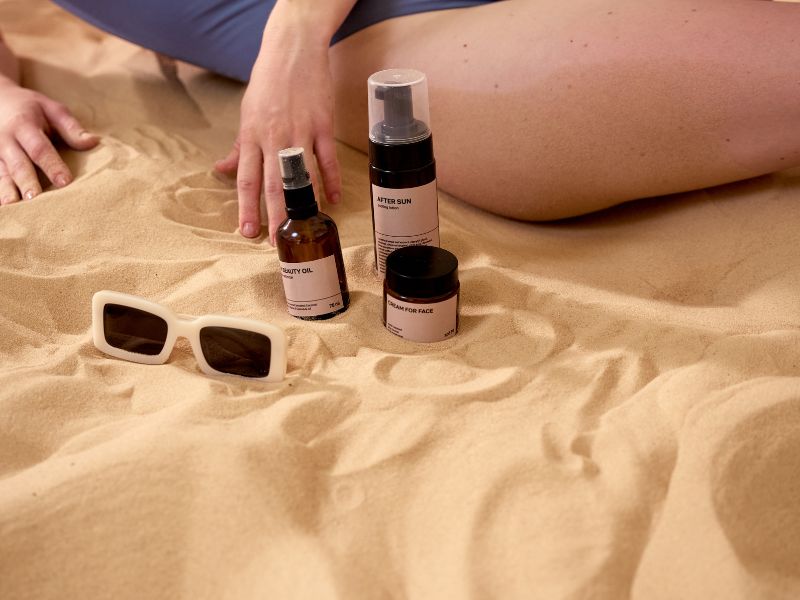Although the sun provides energy, warmth, and life, its rays can also be dangerous. As people’s awareness of skin health grows, some are using sunscreen and other preventive items to shield their skin from the sun, while others are using tanning oils to get a bronzed glow. Nevertheless, these two goods serve different purposes and operate in opposing ways. Making the best decision for your skin requires knowing the difference between tanning oil and sunscreen.
What is Sunscreen
A skincare product called sunscreen is made to shield the skin from damaging UV radiation. It lowers the risk of sunburn, skin damage, and skin cancer by either blocking or absorbing UV rays.
Sunscreen Types
Two main categories of sunscreen exist:
Chemical Sunscreens: These are made of organic (carbon-based) substances that absorb UV rays and convert them into heat that is subsequently expelled from the skin. Chemical sunscreens frequently contain ingredients like octinoxate, avobenzone, and oxybenzone.
Physical (Mineral) Sunscreens: These sunscreens bounce UV rays away from the skin by forming a physical barrier on the skin’s surface with minerals like zinc oxide and titanium dioxide.
How Sunscreen Works
The SPF (Sun Protection Factor) rating indicates the level of protection a sunscreen offers. For instance, SPF 30 means that it would take 30 times longer for UVB rays to redden the skin compared to wearing no sunscreen.
Benefits of Sunscreen
- Protects Against Sunburn: Sunscreen prevents sunburn by blocking UVB rays.
- Reduces Skin Cancer Risk: Sunscreens play a crucial role in reducing the risk of skin cancer by protecting the skin from DNA damage caused by UVA and UVB rays.
- Prevents Premature Aging: Sunscreen helps in reducing signs of aging, such as wrinkles, hyperpigmentation, and sagging, caused by prolonged UV exposure.
Tanning oil: what is it?
By drawing more UV rays to the skin, tanning oils are treatments that speed up and improve the tanning process, resulting in a deeper tan. They usually include oils and moisturizers that soften the skin and speed up tanning.
How Tanning Oil Works
Tanning oils often contain substances like coconut oil, olive oil, and other natural extracts, coupled with tyrosine—a chemical that increases melanin synthesis. Although some tanning oils contain a slight SPF (often less than 15), their main purpose is to draw in UV radiation to make the tan stronger rather than to shield the skin from them.
Benefits of Tanning Oil
- Promotes a Deep Tan: Tanning oil accelerates the tanning process by increasing UV ray absorption.
- Hydrates the Skin: Most tanning oils contain moisturizing agents that prevent the skin from drying out in the sun.
- Leaves a Radiant Glow: Tanning oil gives the skin a radiant, glowing finish, which can last long after the tan is achieved.
Key Differences Between Sunscreen and Tanning Oil
Primary Purpose
- Sunscreen: Protects the skin from UV damage.
- Tanning Oil: Enhances tanning and deepens skin tone.
SPF Level
- Sunscreen: Typically ranges from SPF 15 to 100, designed for maximum protection.
- Tanning Oil: Usually has a low SPF level (often SPF 15 or lower) or no SPF at all.
UV Protection Mechanism
- Sunscreen: Contains UV-blocking ingredients that either absorb or reflect UV rays.
- Tanning Oil: Lacks UV-blocking ingredients and increases UV exposure to the skin.
Effect on Skin Health
- Sunscreen: Protects against aging, hyperpigmentation, and skin cancer.
- Tanning Oil: Increases UV exposure, raising the risk of skin damage if used excessively.
Ingredients: What’s Inside?
Understanding the ingredients can help in making an informed choice. Here’s a breakdown:
Sunscreen Ingredients
- Chemical Sunscreen: Oxybenzone, avobenzone, and octinoxate are active ingredients in chemical sunscreens that absorb UV radiation.
- Mineral Sunscreen: Zinc oxide and titanium dioxide provide a barrier, reflecting UV rays away from the skin.
- Antioxidants and Moisturizers: Many sunscreens are infused with antioxidants like vitamin E to reduce free radical damage and ingredients like hyaluronic acid for hydration.
Tanning Oil Ingredients
- Natural Oils: Components such as jojoba, coconut, and olive oils soften and hydrate the skin, resulting in a smooth tanning surface.
Bronzing Agents: A few tanning oils include bronzers, which give the skin an immediate shine.
Tyrosine: This amino acid accelerates the tanning process by increasing the formation of melanin.
Low SPF: While it’s not enough for extended sun exposure, some tanning oils contain a low SPF to provide just a modest amount of sun protection.
Pros and Cons of Sunscreen and Tanning Oil
Sunscreen
Pros:
- High SPF levels protect against sunburn and skin damage.
- Reduces skin cancer risk.
- Helps prevent premature aging.
Cons:
- Can be sticky or leave a white cast on the skin (especially mineral sunscreens).
- Some people may be allergic to specific chemical ingredients.
Tanning Oil
Pros:
- Enhances the tanning process for a darker, faster tan.
- Contains moisturizing ingredients that keep skin hydrated.
- Gives a healthy glow to the skin.
Cons:
- Low SPF means limited protection against UV rays.
- Increases risk of skin cancer and premature aging if used excessively.
- May clog pores, causing breakouts in sensitive skin types.
Choosing the Right Product for Your Needs
The choice between sunscreen and tanning oil depends on your goals and skin type.
If You Want Protection
- Sunscreen is the best choice for those seeking to protect their skin from harmful UV radiation, reduce signs of aging, and lower their risk of skin cancer. Sunscreen is especially crucial for those with fair skin, who are more prone to sunburn.
If You Want a Deep Tan
- Tanning oil can help you achieve a faster, deeper tan. However, it’s important to use tanning oil sparingly and with caution, ideally applying a broad-spectrum sunscreen underneath to minimize skin damage.
Sensitive Skin Concerns
- Mineral sunscreens are ideal for those with sensitive skin, as they are less likely to irritate. Tanning oils can clog pores, so they may not be ideal for those prone to acne or breakouts.
Misconceptions About Sunscreen and Tanning Oil
“Tanning Oil Protects the Skin”
Some tanning oils come with a low SPF, but it’s not nearly enough to shield the skin from harmful UV rays, especially during extended exposure. Relying solely on tanning oil for sun protection can lead to severe sunburn and long-term skin damage.
“Higher SPF Means No Tanning”
SPF doesn’t entirely block tanning; rather, it prolongs the time before sunburn occurs. Even with SPF 30 or 50, it’s possible to tan, though more gradually.
“Sunscreen Stops Vitamin D Absorption”
While sunscreen does limit some UVB rays, studies show that brief, everyday exposure to the sun without sunscreen is usually sufficient for Vitamin D. Sunscreen usage is not likely to cause a vitamin D deficiency.
The Importance of Aftercare
Aftercare is essential whether you use sunscreen or tanning oil.
- After Sun Exposure: Use aloe vera gel or a cooling lotion to soothe sun-exposed skin.
- Moisturize: Hydrate your skin after sun exposure to restore moisture and repair any minor damage.
- Exfoliate Gently: To prevent clogged pores from tanning oils, use a gentle exfoliator in your post-tan skincare routine.
Conclusion
Your lifestyle and skincare objectives will ultimately determine whether sunscreen or tanning oil is best for you. Sunscreen is your go-to product if UV protection and skin health are important to you. Tannin oil could be OK for occasional usage if you want a darker tan and are aware of the hazards. For tanning lovers, a safer option may be found by finding a balance between sunscreen as a base and tanning oil applied lightly on top.
Never forget that long-term skin health depends on sun safety. You may enjoy the sun while maintaining healthy, glowing skin by using safe sun practices, regardless of the product you use.






